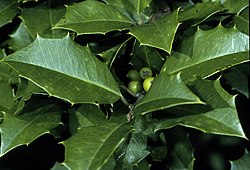Ilex opaca
| Ilex opaca subsp. var. | American Holly | |||||||||||||||||||||||||||||||||||||||||||||||||||||||
|---|---|---|---|---|---|---|---|---|---|---|---|---|---|---|---|---|---|---|---|---|---|---|---|---|---|---|---|---|---|---|---|---|---|---|---|---|---|---|---|---|---|---|---|---|---|---|---|---|---|---|---|---|---|---|---|---|

|
|
| ||||||||||||||||||||||||||||||||||||||||||||||||||||||
| ||||||||||||||||||||||||||||||||||||||||||||||||||||||||
Ilex opaca (American Holly) is a species of holly, native to the eastern United States, from coastal Massachusetts south to central Florida, and west to southeastern Missouri and eastern Texas.[1]
The European Holly does not grow in the climate of most of the United States, but the American Holly makes an excellent second choice for it closely resembles the European species. The leaves are similar in outline and toothed and bristled very much the same way, but they are a paler green and the surface gloss is duller than in the European species.[2]
It is often planted as an ornamental plant, although a slow growing one. Over 1,000 cultivars have been selected, including plants selected for cold tolerance ('Cobalt', a male cultivar, is able to tolerate temperatures as low as −32 °C), growth form (e.g. dwarf forms such as 'Cardinal Hedge', a female plant growing to 1.2 m tall), and color and abundance of fruit (notable female cultivars including the large-berried 'Yule', and the yellow-berried 'Canary' and 'Morgan Gold').[3]
The species typically grows as an understory tree in forests. It is rare and small in the north of its range (parts of coastal New England to Cape Cod), while abundant and larger further south (S Arkansas and E Texas). The branches are short and slender. The roots are thick and fleshy. It will grow in both dry and swampy soil, but grows slowly.[1][2]
The berries are reputedly poisonous to humans, but are important survival food for birds.
| Standard Cyclopedia of Horticulture |
|---|
|
Ilex opaca, Ait. (I. quercifolia, Meerb.). American Holly. Tree, with spreading short branches, sometimes to 50 ft., forming a narrow, pyramidal head, glabrous: lvs. oval or elliptic-lanceolate, with large remote spiny teeth, rarely entire, dull green above, yellowish green beneath, 2-4 in. long: fr. dull scarlet, usually solitary, globose. June. Mass, to Fla., west to Mo. and Texas.—Hardier than I. aquifolium, but less handsome. Ilex opaca var. xanthocarpa, Rehd. Frs. yellow.
|
Cultivation
Propagation
Pests and diseases
Varieties
Gallery
-
Closeup of Bark
-
photo 1
-
photo 2
-
photo 3
References
- Standard Cyclopedia of Horticulture, by L. H. Bailey, MacMillan Co., 1963
External links
- w:Ilex opaca. Some of the material on this page may be from Wikipedia, under the Creative Commons license.
- Ilex opaca QR Code (Size 50, 100, 200, 500)

